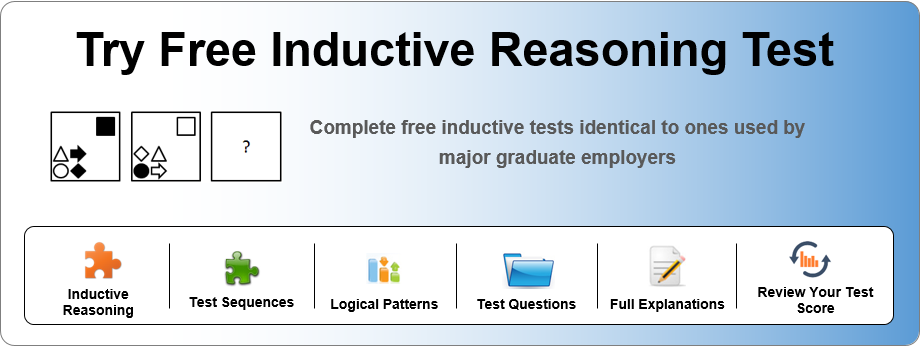Tricky Questions in Inductive Logical Tests
If you’re struggling to analyse and make sense of visual patterns or sequences containing abstract symbols it doesn’t mean that you don’t have a gift or innate ability for it. It just means that you need to train your mind and brain in similar fuzzy intellectual exercises to apprehend principles governing analogies that will allow you to make sound judgments. Note that seeing improvement in your score may be long term process; it requires time, energy and patience. You probably may not see the changes on a day-to-day basis but rather you are likely to see them after some period has passed. Below we have put together some tricky questions to help you in your preparation for logical reasoning tests. If you require more practice materials you can see our guide on inductive aptitude tests where you can study wide range of tutorials to help you enhance your logic comprehension skills. Alternatively you can undertake free inductive reasoning test to see how you would be able to tackle set of real assessment questions under time constraints.
 |
In logical tests of inductive reasoning the principles of measurements are build on analysing patterns by means of which a conclusion is drawn from such set of information. A good example to demonstrate this is the series below. Take no more than 30 seconds to identify what tile comes next.
 |
The signs in the boxes may not give much sense at first glance however if you take hard look and inspect the pattern carefully you will notice that all of the symbols are back to back letters. For example, first box displays C back to back, following D in the second tile, the letter F is displayed back to back in the third tile and L in the fourth box. As you can see from the five answer choices provided A must be the correct answers as it is only the tile that shows letter from alphabet back to back. The other tiles merely show signs but no letters of alphabet. Hence, when completing logical test of inductive reasoning involving series you must inspect tiles in each step of the sequence in strategic and methodical way.
Now let’s review another tricky question that could become e a great puzzle for large number of test takers. Again, set your timer for 30 seconds and see whether you can get it right.
 |
The above figure pattern may be difficult to solve for many students. If you are looking at the sequence and you are searching for rule that make shapes to move from one side of the tile to another then you go the wrong way. Note that it rather displays the relationship between shapes. In other words shapes at both sides must be equal. You can easily spot that if one triangle equals two squares and one square equals two circles then to get equilibrium you need to have one triangle to four circles, hence the correct answer from the five answer choices given must be E. Remember, to succeed at logical or inductive reasoning tests you need to employ a particular method or reasoning and you have to think of number of different ways to tackle the connectives of the items.

